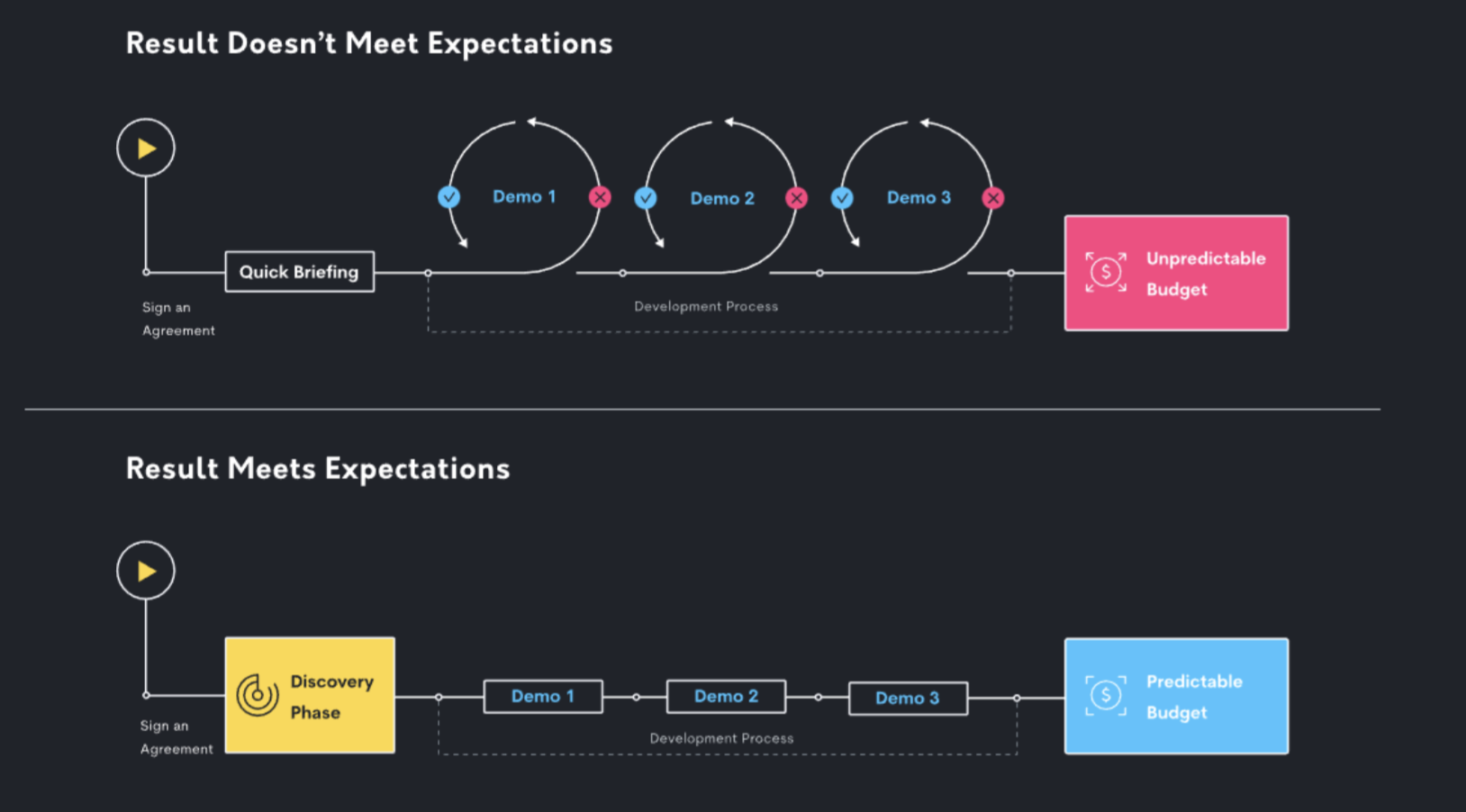Nearly 20% of new businesses in the US don’t survive long enough to celebrate their second anniversary. In Europe, the situation is similar. The UK statistics show that 20% of small businesses fail in their first year. Moreover, around 60% of them close their doors within the first three years.
The most common reason why it happens is a lagging business growth plan. Without analyzing the conditions of anticipated growth and creating strategies to account for them, a company can’t manage the market volatility and shuts down.
We at S-PRO understand how important business growth strategies are, as we grew from a small company with just two team members into a software development and IT consulting service provider with more than 250 employees. Since 2014, we have been helping startups and scale-ups to succeed. In this article, we want to share some insights about business growth.
What is a Business Growth Strategy?
A business growth strategy is a plan to increase sales, promote a brand, improve customer service, and, as a result, boost revenue. It chooses goals for expansion and assumes future challenges.
A good business growth strategy is like a tailored outfit. As long as it is unique and suits a specific occasion only, blind copying will not help.
How to create a Business Growth Strategy?
To create an effective growth strategy plan, follow the guidelines below.
Define Growth Goals
State goals that define where to proceed and how to interpret your results. Robust business growth strategies rely on the SMART framework. The acronym stands for:
- Specific. A specific goal links to only one narrow notion, metric, or idea. For example, "increasing sales" is too general. You should concretize it with a channel or product.
- Measurable. A measurable goal tracks progress, for instance, by 30% or two times.
- Attainable. An actionable goal is achievable. You should know how to achieve the goals contained in a growth strategy plan.
- Relevant. Choose goals pertinent to your current phase.
- Timely. A timely goal should fall within a specific time — year, quarter, month, etc.
Though the SMART framework is not the only one to describe goals, it is very popular. However, goals alone can not substitute a roadmap or detailed action plan.
Create a Roadmap
After goals are written, research the market to ensure that they correspond to the business environment. You might conduct a survey or look at existing studies. With this information, you can come up with an approximate budget, deadlines, and action plan.
Then write a comprehensive roadmap describing how to reach the goals. Specify the required measures and resources. For example, the roadmap may include the automation of some processes or customer support enhancement.
Evaluate Your Risks
Your growth business model should account for possible future challenges. You must evaluate, prioritize and address risks to make a business grow safely. Such hazards may originate both within and outside your organization and external threats:
- Human risks, such as abuse, fraud, or a situation when your key developer suddenly fires, can distort your company's operation.
- Technology and operational risks include power outages, cyber frauds, system failures, etc.
- Strategic risks involve changes in the market, like underestimation of competitors, industry changes, and shifts in demand.
- Financial risks include pricing, currency exchange, or liquidation of an asset, payment defaults so on.
Competitive growth strategies should account for as many risks as possible.
Identify your Value Proposition
The next step of growth strategy development is to consider why people address your company and your product.
Start by studying your current clients. Consider which consumers are most valuable for your organization. Why do they buy your products or services? Is it fast delivery or exceptional quality of the goods? Consider what makes you unique.
Take a closer look at your competitors. Knowing their pros and cons, you can find out what adjustments in your own business to make to gain a more significant market share.
Analyze and Repeat
Analyze the results of your new market growth strategy after its implementation. How much time it will take to display its effectiveness depends on its peculiarities. You may need a month to evaluate an advertising strategy or even days if we are talking about social media promotion. However, to see the results of organic growth strategies, you might wait more than two months.
In any case, assessing the outcome, consider the entire perspective. Review both your accomplishments and setbacks.
All the steps are combined in a cycle, ensuring steady business growth. Define goals, scan the environment, choose performance metrics, implement the strategy, analyze results – and then repeat the cycle again.
What are the Types of Business Growth Strategies?
Businesses may grow in different ways. These are the most common approaches to how they do it.
Product Development
A product development strategy is required when a company wants to increase an assortment within the same market.
For example, a soda company sells regular and caffeine-free versions of one product. In this case, adding new clients and increasing appeal help to boost the revenue.
At this point, meeting or exceeding client expectations is an essential factor. Even a slight alteration may appeal to new clients. Refer to the data of your niche, and you will understand what exactly your customers want.
Market Penetration
Market penetration is a business growth strategy according to which a company tries to increase its market share. Usually, it leads to price competition when businesses cut their prices.
An illustration of this technique is a huge Mother's Day sale to draw in new consumers looking to buy gifts.
Advertising, social media campaigns, and direct sales in untapped market sectors are all about increasing market penetration.
Market Expansion
This tactic involves expanding your present product or service into new markets. In particular, you may discover new applications for your products to promote sales. For instance, a white vinegar producer can claim their product has numerous applications, like cleaning the house and washing machines.
Market expansion is a good organization growth strategy to launch a product or service to a market that has yet to be penetrated.
Partnership Growth Strategy
One way to start selling new goods and services to a new market is through an expansion approach. However, businesses can hardly predict how a brand-new product will perform in a new market. Therefore, teaming up or merging with other companies can provide important advantages. For example, fashion designers double their offerings range by collaborating on a niche scent.
This approach entails a rapid deployment of resources. At the same time, a partnership growth strategy plan yields quicker results than an organic growth plan.
Which Businesses Can Benefit from?
The choice of business growth strategy depends on business objectives. However, the size of a company can also influence your decision. Further, we will describe this correlation.
Startups
The most likely candidates to implement a growth strategy plan are startups, mainly when they are funded by venture capital or investors who don't mind waiting a while for their investment return.
Startups frequently create and implement business growth strategies for their products as they are at the initial stage of business evolution. Product development or partnership growth strategy corresponds to their goals the best. The first one will help to gain market share, and the latter will speed up this process.
Small Businesses
Small firms usually show an organic growth business model in action. They already have a pool of devoted clients. However, they must be frugal with their spending because of insufficient funding.
Nevertheless, you may often see tiny enterprises that choose to increase their market share by entering a price competition with massive market players. As a result, they fail. A market expansion strategy is a more appropriate choice for them.
Enterprises
No matter how big a company becomes, there's always room for expansion. National corporations become international, then intercontinental and global.
Corporations, possessing profuse cash and internal resources, can accommodate the best teams and business divisions. They regularly apply a partnership growth strategy. However, they are not limited to it, given their substantial internal resources.
How S-PRO Can Help Your Business Grow
Our expertise goes beyond producing high-quality code. We offer a unique service for our clients – the Product Discovery Phase. It helps business owners accomplish their objectives on schedule and within budget as part of their business growth strategies. Let’s see how this service works.

Discovery Phase involves thorough research of the market, competitors, and target audience. We define the project's goals, the scope of work, and limits and evaluate commercial prospects. As a result, we create a solution vision. This process ensures the success of the future product.
We can deal with the uncertainties of the project during this period. It helps to:
- set clear goals
- address potential challenges and minimize risks
- establish a product roadmap
- build trust between our company and the client.
Helping Niche Players to Boost Their Businesses: TSO Case Study
Collecting and analyzing information about your customers, market, and niche potential allows us to outline the solution's goals, the scope of work, and limitations. It was an approach we used to create a unique food delivery program for a small and cozy Chinese kitchen restaurant TSO, located in Texas, USA.
Target audience research revealed that local restaurants attracted young individuals who placed orders online. They value their time and appreciate eating healthy food. TSO was just the right fit for them.

That is why we developed a web platform focused on food delivery. It boosts loyalty by providing fast and comfortable service.
We made the platform adaptive instead of launching an app only for Android and iOS. The flexible layout adapts to every device. Ordering via the website is more convenient than ordering via phone. People can see the whole menu, so they will likely order appetizers or try something new.
Another vital part of the project was the admin panel development. Fast and smooth ordering, cooking, and delivery are essential for business success. So we needed to create a platform to satisfy business requirements.
As a result, we built a user-friendly platform that received good customer reviews and helped to achieve the business goals.
Final Thoughts
If any company intends to scale up, it should have a reliable growth strategy plan. There are various business growth strategies, a choice depends on the company’s objectives and market conditions.
A sturdy growth strategy comprises a set of actions to analyze the business environment, customers’ demand, and possible hazards. Moreover, the size of the company also influences the way it operates in the market.
Creating a growth strategy and implementing it can seem like arduous work. Contact us if you need a reliable software development partner to enhance the evolution of your company. Every day, S-PRO helps its clients to scale up and meet their business objectives – and we can help you too!





